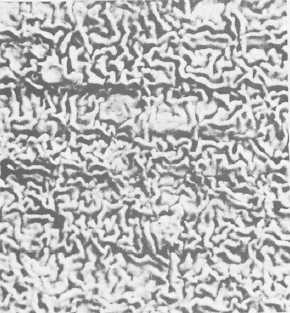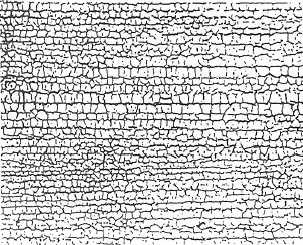Figure 8-7.—Wrinkling.
Chalking
Chalking (fig. 8-8) is the result of paint
weathering at the surface of the coating. The vehicle is
broken down by sunlight and other destructive forces,
leaving behind loose, powdery pigment that can easily be
rubbed off with the finger. Chalking takes place rapidly
with soft paints, such as those based on linseed oil.
Chalking is most rapid in areas exposed to sunshine. In
the Northern Hemisphere, for example, chalking is most
rapid on the south side of a building. On the other hand,
little chalking takes place in areas protected from
sunshine and rain, such as under eaves or overhangs.
Controlled chalking can be an asset, especially in white
paints where it acts as a self-cleaning process and helps
to keep the surface clean and white. The gradual
wearing away reduces the thickness of the coating, thus
allowing continuous repainting without making the
coating too thick for satisfactory service.
Do not use a chalking or self-cleaning paint
above natural brick or other porous masonry surfaces.
The chalking will wash down and stain or discolor these
areas.
Chalked paints are generally easier to repaint
since the underlying paint is in good condition and
requires little surface preparation. But, this is not the
case with water-thinned paints; they adhere poorly to
chalky surfaces.
Checking and Cracking
Checking and cracking are breaks in a coating
formed as the paint becomes hard and brittle.
Temperature changes cause the substrate and overlying
paint to expand and contract. As the paint becomes
hard, it gradually loses its ability to expand without
breaking. Checking (fig. 8-9) consists of tiny breaks in
only the upper coat or coats of the paint film
Figure 8-9.—Severe checking.
Figure 8-8.—Degrees of chalk.
8-13






